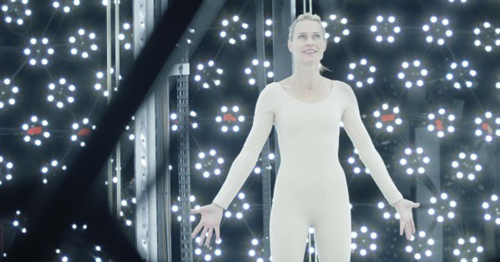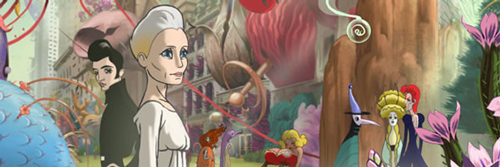|
|
Reviewed by Glenn Erickson
What has Israeli film director Ari Folman been doing since his 2008 international hit Waltz with Bashir? He's taken the leap into science fiction filmmaking, with a half- live action, half- animated feature that continues a modern trend about alternate realities real and perceived, nested inside one another: The Matrix, Inception, The Cabin in the Woods, even Edge of Tomorrow. Ari Folman's movie s a loose adaptation of a story by Polish writer Stanislaw Lem, whose other books have resulted in the East German-Polish space movie The Silent Star and Tarkovsky's Russian classic Solaris.
Folman's film is listed with the title The Congress but the official home video title appears to be the latter, less generic Robin Wright at The Congress. A movie as complicated as this needs to be described in as specific a manner as possible.

Star Robin Wright (Robin Wright) plays a fictional version of herself, which I suppose adds yet another nested reality - in this telling, Wright made The Princess Bride and Forrest Gump, but there's no mention of a marriage to Sean Penn. This Robin Wright is a difficult actress that nobody wants to work with. The other live-action actors play normal roles, not versions of themselves. Miramount executive Jeff Green (Danny Huston) and Robin's trusted agent Al (Harvey Keitel) give her an offer that it would seem unwise to refuse. The movie industry is going through yet another technical revolution, and all on-screen actors will soon be replaced by computer-generated. They have eliminated the filming process with its attendant problems; actors lease their likenesses, voices, and personalities to film companies, who digitize them in detail, a chore that takes half a day. Instead of 'motion capture', the process is 'actor capture'. Her acting presence will from this point on be controlled by the studio. Robin will be paid for doing nothing, but she'll also have no choice in roles, dialogue, etc., beyond some clauses Al secures for her contract that keep Miramount from placing her likeness in porn, etc. She's supposed to sign, be scanned and then go away and wait for the paychecks to come in. Robin initially refuses but relents because she needs the money for doctors for her son Aaron (Kodi Smit-McPhee), who has a malady that is taking away his sight and hearing. Dr. Baker (Paul Giamatti) confirms that Aaron's diagnosis is not good.
Twenty years later, a visibly aged Robin is invited to a special entertainment 'Futurological' Congress' in a desert oasis called Abrahama City. Her scanned likeness is still popular in a recurring serial with an action heroine named 'Rebel Robot Robin'. Abrahama city is in an 'animated zone' populated not by flesh and blood people but animated cartoon versions of themselves. By this time drugs and entertainment have merged into one entity. Robin drinks a vial of serum and is transformed into an animated image that exaggerates her features but still looks like her, including details that show her age. She interacts with other people as if living in a hologram version of a graphic novel. Other stars are there, notably a caricature of Tom Cruise. She meets the likewise animated Dylan Truliner (the voice of Jon Hamm), who was the animator-designer of her movies; he's sought her out because he's in love with her. Robin has come to renew her contract and speak, but when she takes the dais she denounces the practice of humans being turned into commodities. As she's being arrested, the Congress comes under assault by dissident terrorists seeking to restore the natural order.
Another time jump occurs to a ruined future where the privileged live in safety, high in airships. She finds Dr. Baker, now a bearded old man, who tells her that her son Aaron got tired of waiting for her. Just a few months before he took an evolutionary step to the next level of existence, which is a fully animated dimension from which there is no return. The depressing 'real world' is quickly disappearing. The transformation involves yet another serum ('drink me?"). Robin finds Dylan again, but must make a choice -- stay with Truliner or drink the ampule that will allow her to follow Aaron into the next existence. If she does she'll lose Dylan forever, as anybody who passes over inherits a new identity and consciousness -- as Aaron already has. Unlike animated zones, this new existence is a 'clean slate'. What will Robin do?
As the Padishah Emperor Shaddam IV says, "Plots within Plots" are what these meta-movies are all about. No doubt any fairy tale or magical 'wonder world' in an ancient story qualifies, as what else is Oz or Fantasia but a plunge into an alternate imaginary world? I joined the ranks of readers blown away by the deep-fried concepts of three books by Philip K Dick, namely Ubik, The Man in the High Castle and The Three Transformations of Palmer Eldritch. These are fantastic mind-warps worthy of one-sentence descriptions. Ubik proposes the existence of an alternate reality in the collective mental projections of people whose brains are only partly dead, after being put in frozen hibernation. The Man in the High Castle takes an historical route, inventing an alternate present (1962) created by the fact of the Axis being victorious in WW2. But was it? The most similar to The Congress is The Three Stigmata of Palmer Eldritch, which imagines drugs that allow recreational 'players' to inhabit the fictional bodies of dolls, but only as long as the expensive drug lasts. This makes them dependent on the companies selling the drugs and the dolls plus their accessories. Cosmic doom arrives when the astronaut/seer/world destroyer Palmer Eldritch returns from another galaxy with a drug that works better than the rival product. Anybody who ingests it goes to a new level existence only to find that they can't return. They have little or no power in this world, which is completely dominated by the mind of the Machiavellian Eldritch.

The well known Twilight Zone episode "It's a Good Life" is about a pint-sized Palmer Eldritch -- we're at the mercy of an immature brat that has control over reality. He's obsessed with the cruel anarchy of children's cartoons, and when he bores of the adults around him, he simply "wishes them into the cornfield". The cornfield is a Purgatory-like horror-hell, perhaps located next-door to The Phantom Zone in the Superman ethos.
All of these stories are about subjective experiences that may prove false; people are tricked into surrendering their bodies and identities for a different mode of existence in a different dimension. The concept of drug addiction is often part of the mix. 1 Other analogies include the mind control factors inherent in advertising, social systems, cults. Also the idea of one's identity, soul, body being owned by a company (or an individual or an alien from another galaxy). It's also like death, which most humans conceive as a passage from one plane of reality to the next, even if the next plane is total obliteration. The idea of people giving up their identities for an unknown or artificial world is satirized when the 'desired world' is a board game with Barbie-like dolls. Yet the idea is valid, as millions play complex computerized role-playing games, meeting other players in an abstract (but real and commercialized) digital dimension. All hail Tron.
Producer George Pal played with similar concepts in his rather messy movie The Power. William Castle's Project X works along similar lines and even uses animation to depict the alternate mental dimension. The first fully-elaborated Sci-fi epic of this kind that I know of is Rainer Werner Fassbinder's TV serial World on a Wire, in which an employee of a futuristic company finds out that people can cross over and become virtual people in a digitized alternate plane. But these 'virtual identity units' don't realize that they're not flesh and blood. The existential crisis comes when they create their own virtual worlds. Our heroes then find evidence that "our" reality is merely somebody else's virtual world.
Stanislaw Lem's book The Futurological Congress critiques the Soviet communist society, but for Robin Wright at The Congress Ari Folman shifts the subject to corporatized big business. The message is that because corporations are in economic control, they will subordinate human society to fit their needs. This new virtual reality manipulation transforms the world. The idea of scanning actors for computer animated simulations cropped up in Michael Crichton's Looker, a thriller that mostly fumbles its own concept. Robin Wright's best scene sees her digitized inside a big Bucky dome lined with lights and cameras. A former cameraman does the scanning and is supposed to run her through a series of emotions, almost like Marion Davies' cute face-making silent movie gag in King Vidor's Show People. What she really needs is a good director to get her to feel the various motions. Her agent Harvey Keitel steps in to inspire her with a childhood story.

Folman basically does well with a story requiring a lot of exposition. On first viewing I probably missed a lot of details but got the essentials. Although the story hook of worrying about little Aaron doesn't really gel, we care enough about Robin Wright to stay invested in her survival. She's trying to make a living, take care of her kids and move out of the shack she lives in. Although a star, she's no longer hot and so is trapped in the public perceptions left by roles like Princess Buttercup. That seems an alternate reality as well - actors sometimes can't shake off the performances they're remembered for, whether good or bad. And aren't actors always saying that they love being able to live part of their lives in a dramatic-fantasy world?
It's a big adjustment when Robin is jolted into the 'animation zone'. The scanning business is of course already a reality. But now we're given little Philip K. Dick- style ampules of magic stuff that turns us into cartoons and everything else into a modernized Toontown from Roger Rabbit, but also with a touch of Dave Fleischer-Betty Boopian stylization. Characters float in the air, inanimate objects can move, all kinds of magic things happen. The cartoon-ized Robin and Jeff Green look interesting, and the Tom Cruise character rather creepy. At some point Miramount has started licensing Robin's likeness -- a clutch of Robin Wrights are seen in the animation zone.
But I'm still a bit confused by the third level, the one that's like a full-on reincarnation experience. It seems to be a continuation of the 'animation zone' and some synopses say that's what it is. But the way Doctor Baker explains it, everybody in the next dimensional level is on the other side of a break in continuity-consciousness. How does any news get back as to what that conditions are over there? Is the exposition incomplete or did I miss essential information? The way Dr. Baker tells it, this next dimension is basically death and rebirth, except that one gets to choose one's new self at some juncture.
At some point we wonder if these multi-dimensional fantasies are cousins to the subgenre of films blanc , using technological detail to connect to our real world. Instead of pseudo-scientific explanations, films blanc propose heaven-earth-hell cosmologies that sidestep the approved Sunday school versions of existence. The (to my mind) offensively imagined What Dreams May Come gives us an imagined afterlife art-directed in the style of famous paintings.
The Congress works well enough on the poetic level, with an ending that could mean a number of things, starting with the "it's just a dream" explanation. I have to say that I was impressed by the quality of animation and the expressive characters. The level of imagination runs high as Dylan and Robin's arms sprout wings and fly through purple skies. Yet this animated world is a nicer place to visit than to check-in permanently. Who this side of Timothy Leary wants to live a steady diet of surreal visions? Do they take a break by periodically changing all the designs? What if they went for a Peter Max Pepperland look? 2 Or a look that says not "Robin at the Congress" but Quasi at the Quackadero? I laugh at Sally Cruikshank's weird world, but I wouldn't want to be part of it, not even for five minutes.

I saw Jon Hamm's name in the credits but didn't even recognize his voice as that of the lovesick animator, Dylan Truliner. We never see Dylan as a normal human. He doesn't want Robin to see him that way either -- perhaps he 'improved' himself when he entered the animation zone.
Interestingly, the long separations and the fantastic time-space warp issues between the Congress's various dimensions bear some coincidental similarities to this year's Interstellar. It seems a necessity for new Sci-fi stories to work in a 'family' angle with parents separated from children. You know, for the human angle. This picture does it perfectly well.
Drafthouse Films' Blu-ray + Digital Copy of Robin Wright at The Congress is a handsome encoding of this interesting Sci-fi adventure. I would describe it as cerebral but accessible. If it were properly promoted I think it could have done well, but today's mainstream market would have insisted on laughs, a sex interest, trendier stars and probably changes to simplify (neuter) its concept.
Ari Folman gives us another interesting audio commentary; he's candid when explaining his movie. Robin Wright takes charge of an interesting interview featurette; she seems happy to play in something so unusual and has definite opinions about the story. A trailer and a promotional spot are included as well as an informational flyer for a digital download. An insert booklet contains an intro by Folman that airs his strong feelings about the future of movies with synthetic characters. He also answers questions about the hiring of Robin Wright and acknowledges that Fleischer was indeed an influence on the animation style. 3
On a scale of Excellent, Good, Fair, and Poor,
Robin Wright at The Congress Blu-ray + Digital Copy
rates:
Movie: Very Good +
Video: Excellent
Sound: Excellent
Supplements: Commentary Ari Folman, featurette with Robin Wright, trailer, promo, digital download, pamphlet with director input.
Deaf and Hearing-impaired Friendly?
YES; Subtitles: English
Packaging: Keep case
Reviewed: December 7, 2014
Footnotes:
1. An editor friend badly injured in a motorcycle accident twenty-five years ago was given morphine. He asked to be given lower doses, because, as he told me, "opiates take you to a place that feels so good and so safe that you never want to come back".
Return
2. The Yellow Submarine is right there at the entrance to the Las Vegas-like Abrahama, so the four years of production gave them time to think of most everything.
Return
3. I remember, while working on 1941 hearing Greg Jein tell me about an article he participated in for an early issue of the magazine Omni. The question he and several other effects experts were asked was, "what would you suggest for the future of special effects?" This was 1978. Jein said that he thought it would be great if computers could mock up 'imitation people' so that characters could be seen doing dangerous or impossible things without putting a real actor in danger. I think he also wished could insert 'little people' into his impressive miniatures that would be more flexible than the little puppets we used.
I believe that in a very few years some company will offer a service wherein a customer can have his face and voice and maybe even his whole body inserted into his favorite movie, taking the place of one of the original actors. In other words, YOU can take the place of Rhett Butler romancing Scarlett O'Hara, sort of like Karaoke but with quality video. Weta is practically doing that now for Christopher Lee in the Hobbit movies. The democratization of cinema will surely allow us to alter famous films with rap-like riffs, samplings, replacements, etc., to our heart's content.
Return

Text © Copyright 2014 Glenn Erickson
See more exclusive reviews on the Savant Main Page.
The version of this review on the Savant main site has additional images, footnotes and credits information, and may be updated and annotated with reader input and graphics.
Return to Top of Page
|

